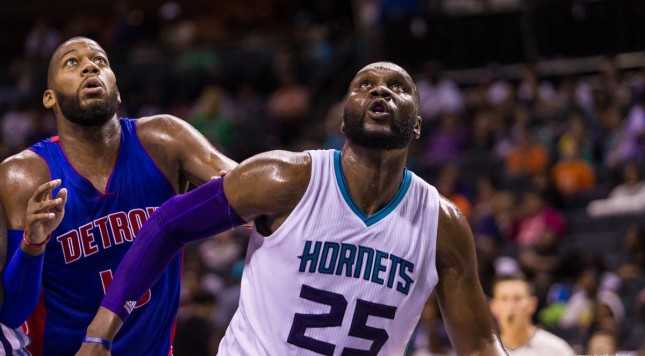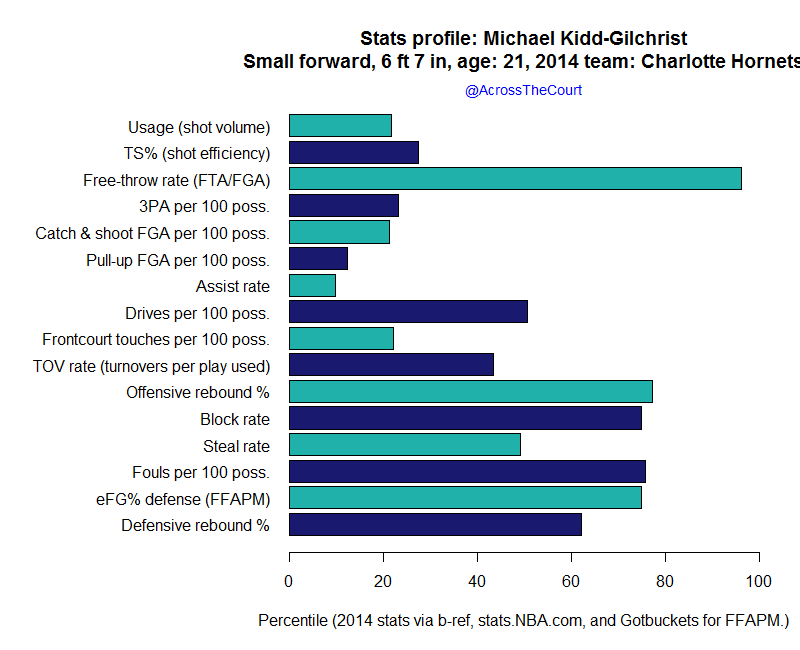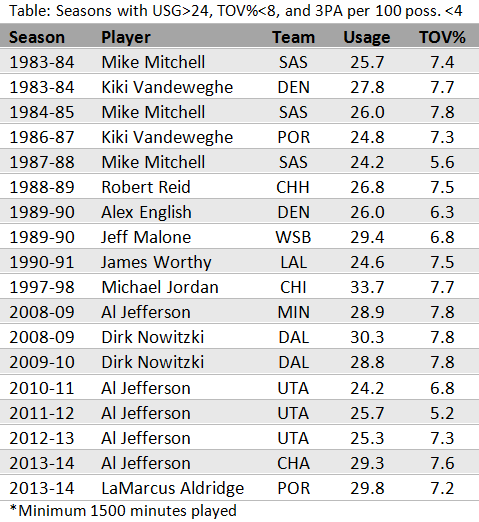The Bobcats have been transmogrified into the Hornets, complete with a makeover of their arena floor into a honeycomb. After making the playoffs and picking up a well-known free agent, spirits are high, but the bar is set awfully low in the east. As one of the more bizarre teams we’ve seen, they’re an all-defense team led by Al Jefferson and Kemba Walker, a team that destroys people on the defensive glass and neglects offensive rebounds, and is building its future with young pieces picked up in recent drafts and the recent signing of Lance Stephenson. Given Lance’s age compared to McRoberts, it was the right move to snag Lance long-term, but we won’t see much of a difference this year unless the team has a major development from one of their young guys.
2014 in review
Charlotte had one of the most remarkable turnarounds ever on defense, but they were overshadowed by the surprises in the west, Phoenix and Portland. After picking up Al Jefferson, people assumed they’d have a major upgrade on offense but their defense would keep them as a longshot to make the playoffs. I was less convinced with Jefferson’s impact, thinking that a low-post center who offers nothing else but rebounding has less value than people assume. In one way I was correct because Charlotte, even though you’d expect them to improve a little anyway because of their age, went from a 28th ranked offense to one ranked 24th for a small increase of 1.3 points per 100 possessions.
Instead Charlotte improbably built on the worst defensive rating in 2013 to the fifth best the next season. That is an astounding change, and it was by importing a center who’s derided on defense and a promotion of Josh McRoberts. Of course, your schedule is easier in the east because there was only one elite offense to defend against, Miami’s, but even adjusted for schedule they were ranked seventh. This was spearheaded by the best defensive rebound rate in the league and they rarely gave up free throws, ranking second there. Their best defender was probably Michael Kidd-Gilchrist, a 20 year-old small forward, and the coaching staff deserves kudos for forming this group into a good defense. However, the offense was still shaky and decidedly below average, and using basketball-reference’s team-rating system they ranked 17th overall (offense and defense) in the league — they were outscored over the course of the season and became a mere speed bump to the Miami Heat. (Al Jefferson got hurt during the series, but before he missed time they weren’t competitive anyway.)
Changes
Exit: Josh McRoberts, Ramon Sessions, Anthony Tolliver, Chris Douglas-Roberts, Luke Ridnour, Ben Gordon, Jeff Adrien, D.J. White, Justin Hamilton, James Southerland.
Enter: Lance Stephenson, Marvin Williams, Noah Vonleh, Brian Roberts, Jason Maxiell.
In the round of musical chairs for stretch 4’s, Frye went from Phoenix to Orlando, Tolliver went from Charlotte to Phoenix, McRoberts went from Charlotte to Miami, and Marvin Williams went from Utah to Charlotte. The Hornets are getting the short end of the stick here, and they’ll miss McRoberts, who always had good ballhandling and passing skills for his position but no one foresaw the leap he made at age 26. Stephenson’s their big free agent signing, but as I discussed in the Indiana review he’s overvalued on offense, pwning a below average usage rate on a poor offensive team. He’s a fine player, of course, and a great role player when his head is screwed on straight, but he’s not the type of all-star material who will put the team over the top. Marvin Williams is a tweener forward who’s lucky the stretch 4 is a coveted piece now; he doesn’t rate as the same player as Josh. Vonleh has a lot of intriguing defensive potential with a huge wingspan and athleticism, but he’s most likely a year or two away from being contributor. Brian Roberts is taking Sessions’ place as the backup PG.
Player spotlight
As a high lottery pick, second overall, much was expected out of Michael Kidd-Gilchrist, but a wayward jump shot has stymied his growth. From the bar chart below, his offensive ineffectiveness is obvious. He infrequently shoots, and when he does it’s inaccurate. He has a tiny assist rate for a perimeter player, takes few jumpers, and touches the ball as often as a center. But when he does try to make plays he’s usually driving to the rim, crashing the boards, and getting fouled.
Gilchrist only received playing time because of his defense. He’s one of the best rebounding wings in the game, and he did that for the best defensive rebounding team. He doesn’t pick up a lot of blocks and steals, but most metrics rate him as comfortably above average. In fact, the stats suggest he induces the opponent into more turnovers than his steals suggest. With his size, athleticism, and age, he’s on track to be one of the best defenders in the league.
The question is whether Michael is the next Tony Allen or the next Trevor Ariza, a big wing who fixed his jumpshot. In the modern NBA, it’s difficult to play a non-scorer and a terrible shooter like Tony Allen. It destroys a team’s offense, and so far he’s one of the worst outside shooters … well, ever. He’s shot a pathetic 28% outside of 3 feet from the rim for his career. Ranking every season since 2001 with at least 100 midrange or three-point attempts by percentage of shots converted, only 1.4% rate worse than his rookie year and only 2.3% rank worse than his second year. The red zone near the right below is almost definitely a blip — he had few attempts and he was terrible there the season before.
The shot attempts from a Kidd-Gilchrist game (link’s also here) versus Toronto are embedded below. Unlike many other athletic wing defenders, he’s not a great finisher at the rim and you can see him get rejected inside on a weak attempt in the first clip. However, he’s crafty at driving with good foot work, which you can see in the second and fourth clips, particularly the latter where he uses a good sidestep/bunny-hop. But you play him for the drive and back off on him because his jump shot is embarrassing. He gets a wide open long-jumper in the third clip because no one would guard him there, and he still bricks it so terribly that another inch to the left it would have been an airball. In the last clip, you see DeMar DeRozan giving him a few feet of space, blocking off a drive, and Michael pulls up with a lot of airspace and misses.
Michael Kidd-Gilchrist often gets a lot of tough assignments, and while he makes a few mistakes his skill can make up the ground. In the first clip below, he blocks Carmelo a fast break with great timing. In the second clip, he blocks a charging Amare Stoudemire at the rim, and then hustles back to his man JR Smith in the corner to chase him off the three-point line. And in the last clip, Carmelo tries to posts him up but when he rises up for a shot Gilchrist meets him higher and swats his shot. In the second embedded playlist, a single video, you can see him fight through a screen and keep up with Paul George, swiping the ball from him too.
Michael Kidd-Gilchrist has been working hard with Mark Price on his jump shot over the summer, completely reworking it. Gone is the awkward release, and the form does indeed look better. If he can become a consistently good enough shooter that defenses have to guard him on the perimeter, he’ll have a long career with a skillset that every team wants to possess with high-level on-ball defense and rebounding.
2015 projected
Optimistically, Charlotte is heading into the season with a finely executed defense with a lot more potential. The aforementioned Kidd-Gilchrist still makes a lot of mistakes and has potential to be special. Stephenson’s a better defender than Henderson and will help displace minutes they gave to defensive non-entities last year like Ben Gordon and Chris Douglas-Roberts. Young kids like Biyombo and Vonleh have high defensive potential and with the proper seasoning and development off their skills, they could create a formidable frontline when Al Jefferson sits.
Charlotte’s weakness, despite what people believe about Al Jefferson, is, quite simply, making shots. Al Jefferson and Kemba Walker were their two main scorers, and both were below average in shooting efficiency. Stephenson can’t take much of the scoring burden — even Gerald Henderson had a significantly higher usage rate — but his playmaking skills will be valued.
The greatest strength the Hornets have on offense is tied to Jefferson, actually: they rarely turn the ball over, ranking first there. People critique Jefferson’s low true-shooting percentage, but at least his abnormally low turnover rate makes up some of the ground. Among players with at least a 2000 minutes, he has the season with the lowest turnover rate ever at a microscopic 5.2%, meaning only one out of every 20 plays he used (shot attempts, trips to the free throw line, or turnovers) ended in a turnover. (Missing the cut-off was Novak, who in 2013 posted an astounding 2.6% turnover rate in 1641 minutes. He had 12 turnovers to 430 field goal attempts.) Most players with tiny usage rates are shooting specialists who don’t put the ball in the floor or score inside. There are only 18 seasons where the player had a usage rate above 24, indicating a large role in the offense, a turnover rate under 8, and fewer than 4 three-point attempts per 100 possessions — those are high scorers who don’t take a lot three’s and rarely turn the ball over, and five of them are from Al Jefferson.
Dirk and Aldridge are fellow power forwards, but both spent a considerable amount of time on the perimeter taking long two-pointers. Jefferson is historically unique, but unfortunately his value is overstated. One of the reasons he has a low turnover rate is that he’s an infrequent passer and a team can’t play through him like teams used to play through the post with Shaq or Kareem, or even Pau Gasol. He’s actually made progress in that area, like he has on defense, but he’s still an empty scorer. For Charlotte to approach 50 wins, they need more offense out of their perimeter players. Kemba Walker is 23 years-old now, and after three years he’s yet to show much progress on offense. He’s the prototypical shooting guard in a point guard’s body, trying his best to run an offense, but he doesn’t have the scoring or elite shooting chops to be a considerable offensive force. For a guard, he’s a poor shooter everywhere. He’s probably overextended in the role as the starting point guard and lead playmaker, which will be made easier by Stephenson’s role.
Yet the Hornets won’t have a net gain in playmaking and passing because McRoberts conjured a young Bill Walton or Sabonis with his playmaking from the high-post. He led the league in the proportion of his touches that led to passes at 87.2%, ahead of pass-first guards like Calderon, catch-and-shoot specialists like Battier, and big men who pass the ball like a hot potato when they rebound like Perkins. He was a great entry passer too, and Jefferson will probably miss his endless supply of passing. Marvin Williams may be his equal with outside shooting, but he passed half as frequently as Josh and his assist rates have always been low. McBobs was perfect for their system on offense. Lance couldn’t coax Indiana into a good offense — they were actually only a half point better than Charlotte — and he had David West in the post and Paul George on the wing. Marvin has alternated between hot and cold seasons lately, and his career average is almost exactly 33%.
Cody Zeller is one choice as a usurper at power forward. A couple years ago, no one would have expected the Plumlee boys to outperform the Zeller’s, but high draft pick Zeller had an unimpressive season after two years in college. Cited for his scoring ability, Cody had awful shooting percentages, particularly away from the rim. It’s likely a bit of a fluke — he’s a decent free-throw shooter, after all — but he was weak on the boards and looked out of sorts, and he’s not out there to protect the rim. Gerald Henderson is one of the more anonymous starters in the league, but he could be moved to the bench and he’s already 26 years-old. He’s a slasher with a usable jump shot and his three-point shooting has been merely acceptable the past couple years. Unless he has a McRoberts like late-blossom, expect more of the same.
Since the east is notoriously weak, the Hornets should gain entry into the playoffs fairly easily, but they’re far from a strong team and if they’re the 8th seed they’ll just be a doormat again for LeBron. But for a playoff team, they still have a good cache of young talent, and their 2015 projection could look goofy if someone, like Lance, has a breakthrough.
Summary
Based on the off-season, signing Lance Stephenson, some people expect the Hornets to make a sizable improvement, but they lost Josh McRoberts and based on the best available evidence there’s little separation in the value of the two players — comparing how well Josh played last season compared to how good Lance will be now, at least. That’s the crux of the disagreement that my projection has with the general public. They’ll have more offense from the wings because of Lance and another good defender, but power forward will be a hole unless one off their young players like Zeller or Vonleh steps up. They’ll hover around 0.500 basketball, but that’s all you need in the east.
Wins: 40
Losses: 42
Conference rank: 7th
League offense rank: 26th
League defense rank: 4th
Edited 10/27/14























